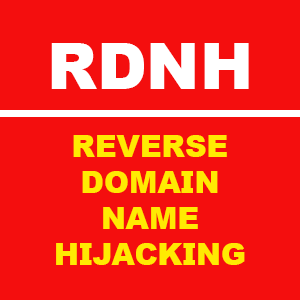
RDNH finding.
The UDRP against the domain name MisterAuto.com didn’t end well for the Complainant, Mister Auto SAS of Villeurbanne, France.
They tried to acquire the aged domain, that was registered in 1999; when negotiations failed, they filed a UDRP.
End result: it’s a case of Reverse Domain Name Hijacking (RDNH.)
That’s what the sole panelist at the WIPO stated, denying the domain’s transfer to the Complainant:
The Panel considers the Complainant launched the proceedings out of desperation as its prior attempt to contact the Respondent went unanswered (and the webpage did not resolve – revealing no clues as to the Respondent’s possible motives) but without a reasonable chance of success and as such in the circumstances constitutes an abuse of the Administrative Proceeding.
Full details on this decision follow:
WIPO Arbitration and Mediation Center
ADMINISTRATIVE PANEL DECISION
Mister Auto SAS v. Wharton Lyon & Lyon
Case No. D2018-13301. The Parties
The Complainant is Mister Auto SAS of Villeurbanne, France, represented by Cairn Legal, Belgium.
The Respondent is Wharton Lyon & Lyon of Livingston, New Jersey, United States of America (“United States”).
2. The Domain Name and Registrar
The disputed domain name <misterauto.com> (the “Disputed Domain Name”) is registered with Network Solutions, LLC (the “Registrar”).
3. Procedural History
The Complaint was filed with the WIPO Arbitration and Mediation Center (the “Center”) on June 14, 2018. On June 14, 2018, the Center transmitted by email to the Registrar a request for registrar verification in connection with the Disputed Domain Name. On June 14, 2018, the Registrar transmitted by email to the Center its verification response confirming that the Respondent is listed as the registrant and providing the contact details.
The Center verified that the Complaint satisfied the formal requirements of the Uniform Domain Name Dispute Resolution Policy (the “Policy” or “UDRP”), the Rules for Uniform Domain Name Dispute Resolution Policy (the “Rules”), and the WIPO Supplemental Rules for Uniform Domain Name Dispute Resolution Policy (the “Supplemental Rules”).
In accordance with the Rules, paragraphs 2 and 4, the Center formally notified the Respondent of the Complaint, and the proceedings commenced on June 28, 2018. In accordance with the Rules, paragraph 5, the due date for Response was July 18, 2018. The Respondent did not submit any response. Accordingly, the Center notified the Respondent’s default on July 19, 2018.
The Center appointed John Swinson as the sole panelist in this matter on July 23, 2018. The Panel finds that it was properly constituted. The Panel has submitted the Statement of Acceptance and Declaration of Impartiality and Independence, as required by the Center to ensure compliance with the Rules, paragraph 7.
4. Factual Background
The Complainant is Mister Auto SAS, a company incorporated in France. The Complainant operates an online store selling car parts and accessories. The Complainant owns a registered trade mark for MISTER AUTO in a number of jurisdictions, the earliest of which was French registered trade mark number 09/3665546, registered on July 21, 2009 (the “Trade Mark”). The Complainant operates its online store at the domain name <mister-auto.com>.
The Respondent is Wharton Lyon & Lyon, a limited liability company registered in Livingston, United States. No Response was received from the Respondent therefore there is little information known about the Respondent. The Disputed Domain Name was registered on October 14, 1999. The Disputed Domain Name currently resolves to an error page.
5. Parties’ Contentions
A. Complainant
The Complainant makes the following submissions.
Identical or confusingly similar
The Disputed Domain Name is identical to the Trade Mark, as it comprises the Trade Mark in its entirety.
No rights or legitimate interests
The Respondent does not have any rights or legitimate interests in respect of the Disputed Domain Name. The Respondent has not been commonly known by the Disputed Doman Name nor has it any registered rights in respect of the Disputed Domain Name.
Registered and used in bad faith
The Disputed Domain Name was presumably registered or acquired for the purpose of selling, renting or otherwise transferring the Disputed Domain Name to the owner of the Trade Mark. It does not appear that the Respondent’s company has been commonly known by the Disputed Domain Name.
The Complainant sent a cease and desist letter to the Respondent on October 20, 2016, stating that the Respondent had used the Complainant’s Trade Mark without authorization, for the purpose of reselling, renting or otherwise transferring the Disputed Domain Name. The Respondent did not respond to this letter.
B. Respondent
The Respondent did not reply to the Complainant’s contentions.
6. Discussion and Findings
To succeed, the Complainant must demonstrate that all of the elements enumerated in paragraph 4(a) of the Policy have been satisfied, namely:
(i) the Disputed Domain Name is identical or confusingly similar to a trade mark or service mark in which the Complainant has rights; and
(ii) the Respondent has no rights or legitimate interests in respect of the Disputed Domain Name; and
(iii) the Disputed Domain Name has been registered and is being used in bad faith.
The onus of proving these elements remains on the Complainant even though the Respondent has not filed a Response.
A. Procedural Issues
The Respondent’s failure to file a Response does not automatically result in a decision in favor of the Complainant (see, e.g., Airbus SAS, Airbus Operations GmbH v. Alesini Pablo Hernan / PrivacyProtect.org, WIPO Case No. D2013-2059). However, the Panel may draw appropriate inferences from the Respondent’s default.
B. Identical or Confusingly Similar
Paragraph 4(a)(i) of the Policy provides that the Complainant must establish that the Disputed Domain Name is identical or confusingly similar to the Trade Mark.
Generally, the test for identity or confusing similarity involves a side-by-side comparison of the domain name and the trade mark to assess whether the trade mark is recognizable within the domain name (see WIPO Overview of WIPO Panel Views on Selected UDRP Questions, Third Edition (“WIPO Overview 3.0”), section 1.7). In this case the Disputed Domain Name is identical to the Trade Mark as it incorporates the Trade Mark in its entirety and no additional words have been added.
The Complainant succeeds on the first element of the Policy.
C. Rights or Legitimate Interests
Paragraph 4(a)(ii) of the Policy provides that the Complainant must establish that the Respondent has no rights or legitimate interests in respect of the Disputed Domain Name. The Complainant is required to make out a prima facie case showing that the Respondent lacks rights or legitimate interests.
The Panel considers the Complainant has made out a prima facie case. This finding is based on the following:
– The Respondent has not used, or made demonstrable preparations to use, the Disputed Domain Name in connection with a bona fide offering of goods or services. The Disputed Domain Name currently resolves to an error page.
– There is no evidence that the Respondent has been commonly known by the Disputed Domain Name, or has registered or common law trade mark rights in relation to this name.
– The Respondent has not been making a legitimate noncommercial or fair use of the Disputed Domain Name, as there is currently no active website associated with the Disputed Domain Name.
The Respondent had the opportunity to demonstrate its rights or legitimate interests, but did not do so. As such, the prima facie case established by the Complainant has not been rebutted and the Complainant succeeds on the second element of the Policy.
D. Registered and Used in Bad Faith
Paragraph 4(a)(iii) of the Policy provides that the Complainant must establish that the Respondent registered and subsequently used the Disputed Domain Name in bad faith.
To succeed in a complaint under the Policy, it is well-established that under the third element of the Policy, the first thing that a complainant must prove on the preponderance of the evidence is that the domain name in issue was registered in bad faith, i.e., was registered with the complainant and/or its trade mark in mind.
Where a respondent registers a domain name before the complainant’s trade mark rights accrue, UDRP panels will not normally find bad faith on the part of the respondent (see WIPO Overview 3.0 section 3.8.1). No amount of subsequent bad faith use can convert a good faith registration into a bad faith registration (Green Tyre Company Plc. v. Shannon Group, WIPO Case No. D2005-0877).
In this instance the Disputed Domain Name was registered in 1999. According to the Complaint, the Complainant first used the Trade Mark in its business in 2008, and obtained registered rights in the Trade Mark in 2010, i.e., after the Disputed Domain Name was registered. At the time the Disputed Domain Name was registered the Complainant had not yet commenced operations of its business, nor did it have any rights in the Trade Mark.
As stated by the panel in Coolside Limited v. Get On The Web Limited, WIPO Case No. D2016-0335:
“In those circumstances, it hardly needs stating that the Respondent cannot conceivably have been aware of the existence, or even potential existence, of the Complainant or of any rights it might subsequently acquire in the [trade mark] at the time of registration. In this Panel’s view, therefore, the Domain Name cannot conceivably have been registered in bad faith.”
The same reasoning applies here. The Complainant has not provided any evidence, nor has it even attempted to make any argument, as to why the Respondent knew or should have known of the Complainant or its future business operations at the time it registered the Disputed Domain Name. Clearly, there is no such argument that can be made. The Complainant states that the Respondent registered the Disputed Domain Name for the primary purpose of selling the Disputed Domain Name to the Complainant. This could not possibly have been the case, as the Complainant’s business did not exist when the Disputed Domain Name was registered. Without this, based on the material before the Panel, there is no basis on which the Panel can find that the Respondent registered the Disputed Domain Name in bad faith.
In light of the above, the Panel finds that the Complainant has not established the third element of the Policy.
E. Reverse Domain Name Hijacking
In coming to a decision, the Panel must have regard to paragraph 15(e) of the Rules, and the following passage in particular:
“If after considering the submissions the Panel finds that the Complaint was brought in bad faith, for example in an attempt at Reverse Domain Name Hijacking or was brought primarily to harass the domain-name holder, the Panel shall declare in its decision that the Complaint was brought in bad faith and constitutes and abuse of the administrative proceeding.”
Reverse domain name hijacking (“RDNH”) is defined in paragraph 1 of the Rules as meaning “using the Policy in bad faith to attempt to deprive a registered domain name holder of a domain name.”
The Respondent has not sought a finding of RDNH in this case. However, it is open to the Panel to make such a finding without a request from the Respondent. In fact, the Panel in Dumankaya Yapi Malzemeleri SAN. VE TiC. A.S v. Domain Administrator, Name Administration Inc. (BVI), WIPO Case No.
D2015-1757 stated that “[i]f abuse is apparent on the face of the case papers, the Panel is under an obligation to declare it”.The Complainant neglected to address the fact that the Disputed Domain Name was registered prior to the Complainant’s first use of the Trade Mark. In the circumstances, it is not possible for the Respondent to have known of the Complainant as the Complainant’s business did not exist. If the Complainant does not exist, the basis on which to find that the Respondent registered the Disputed Domain Name in bad faith are highly limited. The Complainant must have known this.
As stated by the Panel in Chuan Sin Sdn. Bhd. v. Internet Admin (not for sale), Reflex Publishing Inc.,
WIPO Case No. D2014-0557:
“When the Complainant filed the Complaint, the Complainant knew that there was no proper basis for the Complaint yet it went ahead and filed the Complaint. This alone merits a finding of RDNH.See Dextra Asia Co., Ltd. v. Lakeside Enterprises Limited, WIPO Case No. D2012-0403. In so doing the Complainant knew that it was accusing an innocent registrant of dishonesty (bad faith) in the hope that it could deprive the Respondent of the Disputed Domain Name.”
The Panel considers the Complainant launched the proceedings out of desperation as its prior attempt to contact the Respondent went unanswered (and the webpage did not resolve – revealing no clues as to the Respondent’s possible motives) but without a reasonable chance of success and as such in the circumstances constitutes an abuse of the Administrative Proceeding.
7. Decision
For the foregoing reasons, the Complaint is denied.
John Swinson
Sole Panelist
Date: August 3, 2018











